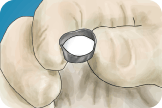Acero XT and 3S Molar Crowns
Indications for use
- Class 2 caries where amalgam and composite fillings would likely fail due to primary tooth morphology and large pulp horns.
- Large, multisurface caries compromising overall tooth structure.
- Following pulpotomy/pulpectomy procedures.
- Developmental defects that cause sensitivity and predispose the teeth to damage from caries such as amelogenesis and dentinogenesis imperfect, and hypocalcification.
Intended Use
Acero XT and 3S Stainless Steel Crowns are designed to provide long-term coverage of primary molar teeth and long-term provisional coverage of permanent molar teeth.
Instructions for use
-
Local anesthesia
Local anesthesia is generally required and the use of a rubber dam strongly recommended.
-
Reduce the occlusal height
Using a tapered fissure bur, produce pilot or guide cuts. Connect the cuts and thus create a uniform occlusal reduction of 1.5 mm. This should reflect the shape of the original tooth.
-
Reduce mesial and distal proximal surfaces
- Slice directly through the proximal surface. Starting from the buccal surface, reduce or eliminate the contact without creating a ledge in the proximal space and/or damaging the approximating tooth. Switch to the distal surface and perform the same procedure.
- The margin should be knife edge with no ledges and approximately 1.0 mm subgingival. Little or no reduction is required for the buccal and lingual surfaces.
-
Remove all existing caries
-
Smooth all line angles
- When multiple adjacent teeth are being prepared, greater interproximal reduction is required for easier crown placement.
- Through a perioprobe or other explorer slide through the proximal surface to ensure there is no contact.
- Preparation should be occlusally square.
-
Round off sharp edges
- Make a final check of the preparation.
- Preparation is not usually required on the buccal or lingual surfaces of primary molars.
-
Select crown
- Select the smallest stainless steel crown that will restore pre-existing proximal contacts.
- Place or seat crown from lingual to buccal.
- Push crown over buccal bulge for snap fit.
- Check margins for close cervical adaptation extending 1 mm subgingivally.
-
Crimp and contour
- Crimping and contouring involves bending the gingival one-third of the crown’s margins inward to establish a tight marginal fit and adaptation.
-
Cement crown
- Dry the tooth and crown. Fill the crown approximately two-thirds full with glass ionomer so that excess cement will flow out from the margins preventing any voids. Spray off excess cement with air and water. An explorer can be used to check for and remove any residual cement along with a knotted floss for interproximal areas.
- Seat crown completely.
-
Remove excess cement
-
Rinse and floss interproximal areas
-
Check occlusion

BASIC SET UP: ACERO MOLAR KIT, KETAC CEMENT, MIXING PAD, SPATULA, HOWE PLIER, CRIMPERS.

HOWE PLIER USED TO FLATTEN INTERPROXIMAL SURFACE (IF NECESSARY).

CRIMPERS TO MODIFY CROWN MARGINS FOR SNUGGER FIT (IF NECESSARY).

KETAC FILLED CROWN READY TO BE CEMENTED.
